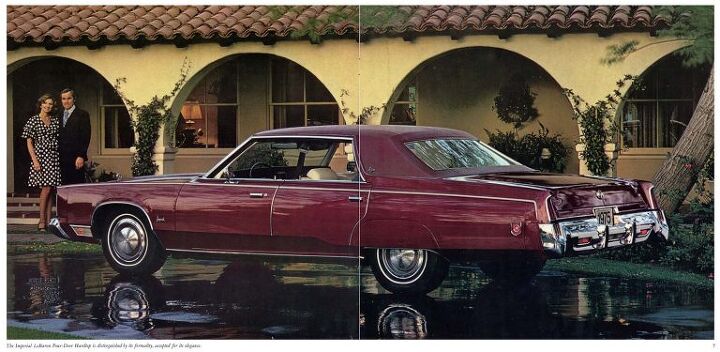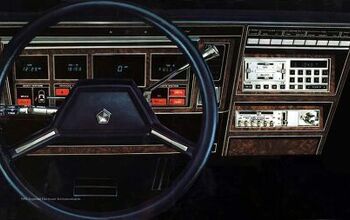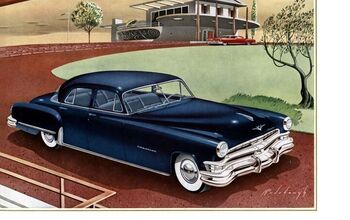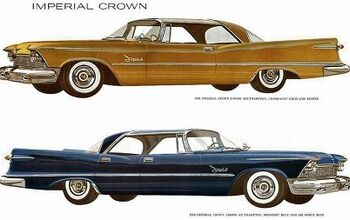Rare Rides Icons: The History of Imperial, More Than Just a Car (Part XVI)

We return to the Imperial story once more today, at a worst-ever moment. The year is 1974, and the future is bleak for the large prestige car. The economy is down, fuel prices are up due to a recent oil crisis, and the market’s trend is toward front-drive vehicles and sedans of a smaller size. What was Chrysler to do with its flagship Imperial in that sort of environment? Kill it off, that’s what.
We covered the new, more traditional styling of the fifth-generation Imperial in our last installment. For the first time in the brand’s history, the Imperial wore the same sheet metal as Chrysler’s lesser New Yorker. Unique styling on the Imperial included the front clip and the trunk lid. Underneath, the sameness continued. In previous versions of the Imperial, the flagship used a longer wheelbase and came with additional length, for “No Chrysler is this long!” marketing reasons.
That changed in 1974 when the Imperial shared the same 124-inch wheelbase as the New Yorker. Said wheelbase was three inches shorter than the 1973 Imperial. Exterior dimensions shrunk too, after the super long 235.3 inches of 1973, 1974 stretched just 231.1 inches. Width increased a hair, from 79.6 to 79.7 inches. Imperial was notably lower too: 54.7 inches over 56.2 inches in 1973.
With this new generation, Chrysler dusted off a historical name in Imperial’s portfolio: Crown. The brand’s top model was no longer the LeBaron hardtop sedan, but rather the pillared Crown Coupe. You may recall Crown was historically the model’s top trim, but was subordinated to LeBaron in the Sixties and disappeared after 1970. The Crown Coupe was a direct attempt by Chrysler to compete with PLC entries like the much more popular Cadillac Eldorado and Lincoln Continental Mark IV.
The pillared sedan was gone once again, as Chrysler played on-then-off with its lowest-priced Imperial. 1973’s body styles were three: The aforementioned two-door coupe, a hardtop two-door coupe, and a four-door hardtop. An interesting detail: The luxurious pillared coupe started out in life as a hardtop, and then was edited from a LeBaron into a Crown at ASC’s assembly line.
Although a new top trim returned, internally the Imperials were identified as 4Y (M), which meant all examples were of a “medium” trim. The coupe as flagship pricing strategy was a new approach for 1974, as the prior year the four-door was $228 ($1,504 adj.) more than the coupe. Even though trim differences were small, Imperial was a smaller vehicle than before, and it lacked the unique body of all prior Imperials, Chrysler raised the prices in 1974.
Every trim was between five and seven percent more expensive, in an economy that was down considerably. The bottom of the range was the LeBaron four-door, at $7,230 ($43,620 adj.), while the hardtop coupe was also a LeBaron trim, and asked $7,793 ($47,016 adj.). The top-spec Imperial Crown Coupe asked $7,856 ($47,396 adj.).
For comparison, the Cadillac Eldorado asked $7,656 ($46,190 adj.) at introduction, but GM jacked its price considerably, to $9,110 ($54,962 adj.) midway through the model year. Neither car could touch the most desirable Continental Mark IV, which asked $10,194 ($61,502 adj.) all year long. Though it wanted more money for the Imperial, Chrysler spent less than ever advertising its prestige brand. There were very few print advertisements, and this generation Imperial was not advertised on television.
Power train changes were naught with the new Imperial in 1974, as Chrysler stuck with its tried and true 440 Wedge V8 (7.2 liters). It was still paired to the same three-speed A727 TorqueFlite, too. By this time the Imperial’s engine was smaller than the competition, as the Mark used a 460 (7.5L) and Eldorado had a full fat 500 cubic inches (8.2L). Though engines stayed the same, there were some electronic differences in the new Imperial. A new starter lock system added protection from would-be thieves, and warning lights were now backed by LEDs instead of traditional bulbs.
With its new body shape and unique waterfall grille, the Imperial had a stylistic advantage over its competition, as they were not new in 1974. At the end of the year, Imperial sold 10,576 LeBaron four-doors, 3,793 LeBaron two-doors, and only 57 Crown Coupes. The brand’s 14,426 total sales were down from 16,729 the prior year but were enough to satisfy the brass at Chrysler. However, those numbers paled in comparison to the competition, where Cadillac sold 40,412 copies just of the Eldorado, and Lincoln sold 57,316 Mark IV coupes.
Chrysler gave Imperial one more shot in 1975 when slight changes turned the 4Y (M) into the 5Y (M). To denote the 1975 model, the front end received an altered waterfall grille that was a bit chunkier looking than before. The vertical slats were a bit thicker, and no longer grouped into sections. The bumper was revised, with two cutouts that functioned as an extension of the grille to aid with cooling.
Grille inserts resided behind the cutouts to make the look more cohesive. As a result of the extra space needed for the lower grilles, Imperial’s overall length grew slightly for its final year in 1975, up to 232.7 inches from 231.1. Fiberglass bumper fillers were extended to accommodate the grilles, and given a ribbed texture.
There were some technological advancements for Imperial’s last year, as spark plugs received platinum tips. The revised plugs were intended to offer a 50,000-mile service life. The battery was sturdier as well and was 500 amperes instead of 440. The government said a catalytic converter was required in 1975, so Chrysler complied across its lineup. The ’75 was a bit more fuel-efficient on unleaded, courtesy of a new rear axle ratio (2.71:1). Standard this year was Automatic Height Control, a load-leveling feature for the rear end of the car. For the first time (and later than the competition), the Imperial also used an electric rear defroster instead of a blower, which was an optional extra.
Another addition in 1975 was the Fuel Pacer System. From the driver’s viewpoint in the pillowed cabin, fender-mounted lamps would flash under two circumstances: When the turn signal was on, or when the driver was driving in such a way to cause poor efficiency. Imagine the fun of being nagged by the car’s warning lights each time a right foot got too deep into the carpet.
Even less emphasis was placed on Imperial advertisements in 1975, as the brand’s fate was already sealed. When the Imperial did appear in an odd magazine or two, it was alongside the Cordoba and the New Yorker. When Imperial appeared on its own, Chrysler often mentioned its other luxury cars in the ad’s text. It was a faux pas Chrysler had repeated for some time, as it failed to get dealers and the public to treat Imperial as a separate entity.
Though the ’75 Imperial was more efficient and had electric rear defrost, the economy was stomping on the large luxury car market. Add in the Imperial’s distant third place in the domestic luxury field, and the outcome of 1975 was not surprising: Chrysler managed just 8,830 Imperial sales in 1975. Not helping matters, prices in ’75 were notably higher than before, at $8,844 ($47,725 adj.) for the four-door Lebaron, $8,698 ($46,937 adj.) for the two-door Lebaron, and $9,277 ($50,061 adj.) for the ASC-made Crown Coupe.
The Crown Coupe had much better sales in its final year, as customers wrote checks for 1,641. There were 1,087 LeBaron two-doors sold and 6,102 sedans. Part of the sales slump was down to the discontinuation of the brand, which leaked in the third quarter of the year. The leak was prior to any planned announcement by Chrysler.
On June 11th, 1975 Chrysler invited auto journalists to Detroit to check out the 1976 Chrysler lineup. And there were no Imperials present. Journalists casually but accidentally told various persons about the Imperial’s death, and by the next day, it was published as a New York Times exclusive. The NYT cited that even in July, Imperial’s sales were already abysmal: 2,808 total, or 55 percent lower than the same time in 1974.
The final independent Imperial rolled off the line on June 12th, 1975, the very day the NYT piece was published. The last one ever made was a black-over-black hardtop sedan. It was a sad day, sort of: Chrysler had a plan in place for 1976. That year the rest of the C-bodies continued under their various Chrysler, Dodge, and Plymouth names, but there was an addition to the New Yorker lineup.
It was a new prestigious top trim: Brougham. The Brougham used the front and rear of the discontinued Imperial, and was essentially the same car. Differences included the replacement of Imperial badges with Chrysler ones and the removal of all Imperial eagle logos. There were a few standard Imperial features moved over to optional extras on the New Yorker Brougham, to made the base price more appealable.
New Yorker was about $2,000 ($10,113 adj.) less expensive than an equivalent and nearly identical Imperial from the year prior. The Brougham had an expensive option available in the $598 ($3,023 adj.) St. Regis package. Exclusive to the coupe, the St. Regis added a thick padded vinyl roof, and the ever-impressive and formal opera window. It was essentially what the Crown Coupe was a year prior.
The rest of the C-bodies continued on through 1978, as the Imperial name was erased from the memory of most everyone. But a few years later there was one man who fondly remembered Imperial, and thought it should return once more as an exclusive luxury car. The man’s name was Lee Iacocca, and he was the new CEO of Chrysler. More on that in our next installment.
[Images: Chrysler]

Interested in lots of cars and their various historical contexts. Started writing articles for TTAC in late 2016, when my first posts were QOTDs. From there I started a few new series like Rare Rides, Buy/Drive/Burn, Abandoned History, and most recently Rare Rides Icons. Operating from a home base in Cincinnati, Ohio, a relative auto journalist dead zone. Many of my articles are prompted by something I'll see on social media that sparks my interest and causes me to research. Finding articles and information from the early days of the internet and beyond that covers the little details lost to time: trim packages, color and wheel choices, interior fabrics. Beyond those, I'm fascinated by automotive industry experiments, both failures and successes. Lately I've taken an interest in AI, and generating "what if" type images for car models long dead. Reincarnating a modern Toyota Paseo, Lincoln Mark IX, or Isuzu Trooper through a text prompt is fun. Fun to post them on Twitter too, and watch people overreact. To that end, the social media I use most is Twitter, @CoreyLewis86. I also contribute pieces for Forbes Wheels and Forbes Home.
More by Corey Lewis
Latest Car Reviews
Read moreLatest Product Reviews
Read moreRecent Comments
- Bd2 Lexus is just a higher trim package Toyota. ^^
- Tassos ONLY consider CIvics or Corollas, in their segment. NO DAMNED Hyundais, Kias, Nissans or esp Mitsus. Not even a Pretend-BMW Mazda. They may look cute but they SUCK.I always recommend Corollas to friends of mine who are not auto enthusiasts, even tho I never owed one, and owned a Civic Hatch 5 speed 1992 for 25 years. MANY follow my advice and are VERY happy. ALmost all are women.friends who believe they are auto enthusiasts would not listen to me anyway, and would never buy a Toyota. They are damned fools, on both counts.
- Tassos since Oct 2016 I drive a 2007 E320 Bluetec and since April 2017 also a 2008 E320 Bluetec.Now I am in my summer palace deep in the Eurozone until end October and drive the 2008.Changing the considerable oils (10 quarts synthetic) twice cost me 80 and 70 euros. Same changes in the US on the 2007 cost me $219 at the dealers and $120 at Firestone.Changing the air filter cost 30 Euros, with labor, and there are two such filters (engine and cabin), and changing the fuel filter only 50 euros, while in the US they asked for... $400. You can safely bet I declined and told them what to do with their gold-plated filter. And when I changed it in Europe, I looked at the old one and it was clean as a whistle.A set of Continentals tires, installed etc, 300 EurosI can't remember anything else for the 2008. For the 2007, a brand new set of manual rec'd tires at Discount Tire with free rotations for life used up the $500 allowance the dealer gave me when I bought it (tires only had 5000 miles left on them then)So, as you can see, I spent less than even if I owned a Lexus instead, and probably less than all these poor devils here that brag about their alleged low cost Datsun-Mitsus and Hyundai-Kias.And that's THETRUTHABOUTCARS. My Cars,
- NJRide These are the Q1 Luxury division salesAudi 44,226Acura 30,373BMW 84,475Genesis 14,777Mercedes 66,000Lexus 78,471Infiniti 13,904Volvo 30,000*Tesla (maybe not luxury but relevant): 125,000?Lincoln 24,894Cadillac 35,451So Cadillac is now stuck as a second-tier player with names like Volvo. Even German 3rd wheel Audi is outselling them. Where to gain sales?Surprisingly a decline of Tesla could boost Cadillac EVs. Tesla sort of is now in the old Buick-Mercury upper middle of the market. If lets say the market stays the same, but another 15-20% leave Tesla I could see some going for a Caddy EV or hybrid, but is the division ready to meet them?In terms of the mainstream luxury brands, Lexus is probably a better benchmark than BMW. Lexus is basically doing a modern interpretation of what Cadillac/upscale Olds/Buick used to completely dominate. But Lexus' only downfall is the lack of emotion, something Cadillac at least used to be good at. The Escalade still has far more styling and brand ID than most of Lexus. So match Lexus' quality but out-do them on comfort and styling. Yes a lot of Lexus buyers may be Toyota or import loyal but there are a lot who are former GM buyers who would "come home" for a better product.In fact, that by and large is the Big 3's problem. In the 80s and 90s they would try to win back "import intenders" and this at least slowed the market share erosion. I feel like around 2000 they gave this up and resorted to a ton of gimmicks before the bankruptcies. So they have dropped from 66% to 37% of the market in a quarter century. Sure they have scaled down their presence and for the last 14 years preserved profit. But in the largest, most prosperous market in the world they are not leading. I mean who would think the Koreans could take almost 10% of the market? But they did because they built and structured products people wanted. (I also think the excess reliance on overseas assembly by the Big 3 hurts them vs more import brands building in US). But the domestics should really be at 60% of their home market and the fact that they are not speaks volumes. Cadillac should not be losing 2-1 to Lexus and BMW.
- Tassos Not my favorite Eldorados. Too much cowbell (fins), the gauges look poor for such an expensive car, the interior has too many shiny bits but does not scream "flagship luxury", and the white on red leather or whatever is rather loud for this car, while it might work in a Corvette. But do not despair, a couple more years and the exterior designs (at least) will sober up, the cowbells will be more discreet and the long, low and wide 60s designs are not far away. If only the interiors would be fit for the price point, and especially a few acres of real wood that also looked real.







































Comments
Join the conversation
Funny how Chrysler offered that Dijon mustard yellowy brown crap color on virtually every product around that time. Throw in that discount dog kibble brown for the vinyl roof and interior and, voila, instant garbage.
I must say I love the Imperials from 1964 all the way through 1975. I don't know what the prices are like now but up until a few years ago the prices were pretty reasonable. I was sorely tempted on several occasions. For better or worse, I didn't bite. But I still wish I had one for long, highway drives.